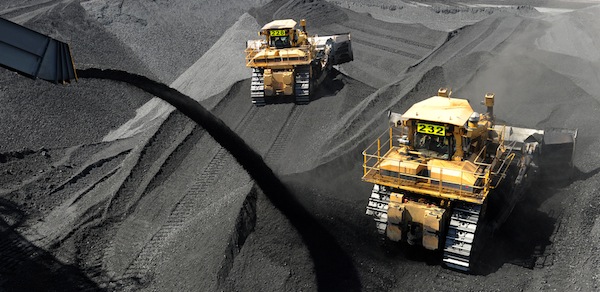The government’s post-2020 emissions target paper suggests it’s aware that it has to lift its game, but it has a massive task. [7 April 2014 | Peter Boyer]
“We are determined to reduce emissions,” declared a media release about climate change issued from Tony Abbott’s office on 28 March, which seems encouraging. But then there’s the track record.

Coal being stockpiled before loading on to ships at RG Tanner Coal Terminal, Gladstone. PHOTO Dave Hunt, AAP
This is the same government which continues to stress that Australia’s long-term future must incorporate a sustained high level of mining, using and exporting coal, the most polluting and carbon-intensive of fossil fuels.
It’s the government which at every turn in opposition attacked climate measures put up by the Gillard administration. The government which said before the election that it supported the 2020 renewable energy target but then pursued a policy of weakening it.
It’s the same government that less than a year ago abolished Australia’s most comprehensive instrument for curbing emissions, the carbon tax. It also tried to axe the Climate Change Authority and two key clean energy agencies but was thwarted in the Senate.
One of those agencies, the Clean Energy Finance Corporation, is being directed by the government to deliver a higher financial return – so high that its job of increasing the flow of finance into the clean energy sector is being made all but impossible.
Next week sees the first permit auction under the government’s own emissions reduction fund. “Early interest is ahead of expectations”, says the government, but there’s precious little expectation anywhere that this $2.55 billion revenue-funded, no-penalty scheme will actually work.
Once, the major parties recognised the importance of working together on key climate policy measures, but that all ended with Tony Abbott’s rise to party leadership.
Abbott’s views about the scientific position that more carbon dioxide (“an invisible substance”) affects our climate (“absolute crap”) have coloured every breezy government claim that its tax-free policies will do the job. If there’s no climate problem, it follows that policies are mere decoration.
Abbott has been down on the United Nations for a while now, accusing the organisation of lecturing him about Australia’s human rights responsibilities. But he seems less inclined to challenge global opinion in preparations for the key UN climate summit in Paris in December.
The Prime Minister, with foreign minister Julie Bishop and environment minister Greg Hunt, has now asked for public submissions on Australia’s post-2020 emissions reduction target. Nations had agreed to post their positions last month, but Australia’s won’t be finalised till September.
Over five years of partisan debate about climate policy has now come down to this moment of truth for the government. A failure to lift its game for the Paris summit will cement its place as one of the key spoilers of global action. Alternatively, it could make this year a turning point.
There are odd hints from the issues paper that the government is changing its tune on climate change, which it describes as “a global problem that requires a global solution”. “A strong and effective global agreement,” it continues, “is in Australia’s national interest.”
The chosen target “will represent Australia’s fair share of the global effort needed to respond to climate change”, the issues paper says. It also emphasises that the target must allow for a business environment to “facilitate decision making and investment”.
Much of the latter is about Australian coal and gas exports, which the paper says will continue indefinitely to supply the world with energy. It says nothing about consequent emissions, nor about repeated scientific advice that we need deep, early cuts to keep warming at a manageable level.
As a source of information the paper fails completely. The main message from its scant five pages is that the government has a huge task ahead of it to build credibility in time for the Paris meeting.
Of the 34 countries that met the agreed deadline for submitting national targets, the United States has promised to cut emissions by at least 26 per cent below 2005 levels by 2025, while European countries have set a much tougher target of 40 per cent below 1990 levels by 2030.
Australia’s Climate Institute believes a national target of 40 per cent below 2000 levels by 2025 is eminently achievable. The Climate Change Authority will release its recommendations on a post-2020 target later this month.
Public submissions are sought by Friday fortnight, 24 April. Information at www.dpmc.gov.au.
THIS is commitment: Last week Jenny Sprent, Stephen Rae and Jen Boocock ran 164 km through the wilds of south-western Tasmania to raise more than $13,000 for the Climate Council, the crowd-funded successor to the Climate Commission, axed by the Abbott government in 2013.
For its part the Hodgman Government abolished the Tasmanian Climate Action Council last year, but most former TCAC members continue to give their time to advocate and inform about climate science and policy, convening a successful Climate Tasmania public forum in Hobart last week.
